- INDEPTH
- Lifestyle
- Good Weekend
This was published 8 years ago
7 kidney donors, 7 recipients, 6 hospitals, 3 cities. What could possibly go wrong?
Medical ingenuity and the kindness of a stranger brought together 14 people in a life-changing event. By Jane Cadzow.
By Jane Cadzow
The way Paul Bannan tells it, the whole thing was serendipitous. His intention was merely to do a favour for a friend. Instead, he triggered the largest exchange of organs in Australian medical history. "I just happened to be in the right place at the right time with the right body part," he says.
Bannan is a 54-year-old tradesman from the Victorian town of Yea, 100km north-east of Melbourne. A few years ago, a friend needed a kidney. Bannan offered him one. "That's what mates do," he shrugs, pointing out his GP was less impressed by his plan to give away an organ than by the steps he took to qualify as a donor: "He said, 'If I'd known this was all it would take for you to give up smoking, watch your cholesterol, cut out sugar and start exercising, I would have cut it out of you years ago.' "
Then something unexpected happened: Bannan's friend got an organ through the transplant waiting list, from a person who had died. What to do? Bannan had lost 20 kilograms and kicked a pack-a-day cigarette habit. It seemed a shame to waste the effort. Rather than cancel a scheduled appointment with The Royal Melbourne Hospital's director of nephrology, Steve Holt, he showed up with a proposal.
Holt recalls the conversation: "I said, 'Well, look, your friend has been transplanted. Good on you for making your lifestyle changes. We don't need to see you again. Thanks for the offer, it was fantastic. Have a great life.' " Bannan was not so easily dismissed. "He said, 'Hang on, can't I give it to somebody else?' "
Holt was taken aback. In more than 20 years as a kidney specialist, he had never been asked that question. To donate an organ to someone close to you is one thing; to put it up for grabs is quite another. Holt remembers saying cautiously, " 'Do you really mean that?' He said, 'Yeah, I've given it a lot of thought and I really want to do it.' " Holt knew who to call.
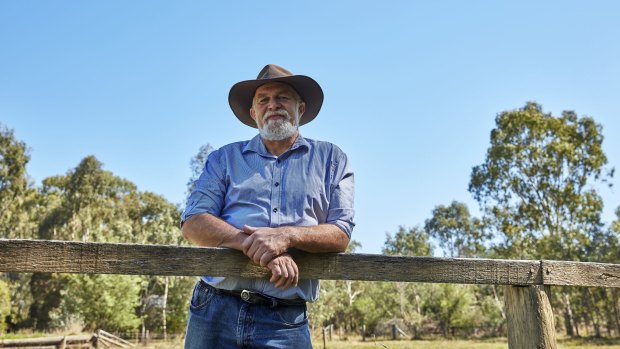
Paul Bannan lost 20 kilograms and gave up smoking in order to donate a kidney.Credit: Thom Rigney
If anyone can put a spare kidney to good use, it's Paolo Ferrari. The Swiss-born nephrologist, based at Sydney's Prince of Wales Hospital, runs a program giving hope to some of Australia's most desperate kidney patients: people who need transplants but have been unable to get them through the usual channels. Incompatible with most organs that become available, some face the prospect of dying on waiting lists. Most have endured the disappointment of learning a kidney offered by a family member or friend is not right for them.
"If someone wants to give a kidney to a loved one but their blood types or tissue types don't match, we traditionally would have told them, 'Tough luck,' " Ferrari says. For some, there is now a way around the problem. Under the Organ and Tissue Authority's "paired kidney exchange program", a kidney patient and his or her willing-but-unsuitable donor can join forces with other pairs in the same predicament. In effect, the donor kidneys become a pooled resource, allocated to the patients for whom they will work best. If an extra organ is thrown into the mix, as happened when Bannan offered up his, the matchmaking possibilities increase significantly.
Which is why, when Bannan walked into the Royal Melbourne just after dawn on November 19 last year, crack transplant teams hundreds of kilometres apart were preparing for 14 synchronised operations.
Seven kidney donors and seven recipients in six hospitals in three cities. What could possibly go wrong?
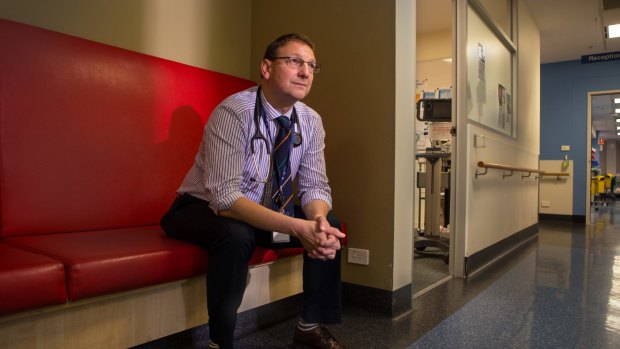
Steve Holt, director of nephrology at Royal Melbourne Hospital.Credit: Simon Schluter
BANNAN HAD MET NONE of the other 13 participants in the exchange. Like the other donors, he had no idea where his kidney would be going. For him, it was enough to know that it would free someone from having to spend several days a week hooked up to the dialysis machines that mimic kidney function. His kidney would improve – and possibly save – a person's life. "I was 100 per cent comfortable with what I was doing," he says.
Steven Masterman had no misgivings, either, yet had spent a restless night in a Royal Melbourne ward. "Lying in a hospital bed thinking, 'Tomorrow I'm going to be minus one kidney' ... It's a strange sort of feeling," says Masterman, 59, who retired from the diplomatic security branch of the Foreign Affairs Department to Bicheno, on Tasmania's east coast. "If I got an hour's sleep, I reckon that would be about it."
During the evening, Masterman had wandered down the corridor to visit his brother, John, 61. Twenty-two years earlier, John had been given a kidney by their mother. It had eventually failed, and he needed another. "I never even thought of not doing it," says Masterman, who hadn't been the only family member to volunteer for a compatibility test. John's wife and sister put their hands up, too. When it turned out that none of the three was a match, it came down to which of them would go into the paired exchange program with John. Who was prepared to give a kidney to a stranger so that John would receive one from someone else?
"I haven't got any children or grandchildren, so I was the obvious one," says Masterman. He laughs. "More expendable."
Another Tasmanian getting ready to go under the knife in Royal Melbourne was Justin Caswell, a 40-year-old Hobart police officer. Caswell's wife, Alex, had been diagnosed with renal disease when pregnant with their son, Max, in 2012. Her condition had since deteriorated. Caswell had hoped to donate a kidney directly to Alex, but antibodies in her system meant the organ would have lasted only a few years. Joining the paired exchange program seemed a better alternative. "I didn't think twice," Justin says. "As long as it meant that Alex got a kidney that had a better prospect of working for her longer than mine would."
At Melbourne's Austin Hospital, Eleanor Canning, 43, was in a room two doors down from her only sibling, 44-year-old Veronica Reid. After being admitted the previous afternoon, the women had eaten dinner and watched a movie together. By morning, both were feeling a bit nervous, though for Canning, a nurse with three children, giving away a kidney to help her sister seemed an entirely natural course of action.
For Sydney chef Leon Sidd, 66, learning that a suitable kidney had been found for his seriously ill wife, Chadia, had felt like winning the lottery. He tells me that as he packed for his stay in Prince of Wales Hospital, "it was like I was going on a holiday". At Newcastle's John Hunter Hospital, underground mine worker Michael Deaves, 55, was similarly upbeat. To secure a kidney for his wife, Elizabeth, surrendering one of his own seemed a small price to pay. Deaves admits though that as he waited to be collected for surgery, his enthusiasm for the scheme wavered. "You hear the trolley coming to get you," he says, "and you think, 'Oh shit, here we go.' " to minimise the chance of having a donor back out, the seven kidney removal operations were scheduled to start at the same time. "Donors can withdraw consent at any stage," explains Royal Melbourne's Steve Holt. And one person getting cold feet would be enough to stop an entire chain of transplants from going ahead. "We've never had that happen," Holt says, "but obviously it's something that's in the back of your mind."
Claudia Woodroffe, co-ordinator of the paired exchange program, had spent the previous evening willing her phone not to ring: she knew from experience that all it took for an exchange to be cancelled at the last minute was for a donor or recipient to develop a temperature. She felt better now that all the donors were in the operating theatres, with anaesthetic dripping into their veins. At 8.37am, she sent the theatres a text message: "All donors confirmed asleep." This was the signal that surgery could begin. Woodroffe had a celebratory slug of Diet Coke. So far, so good.
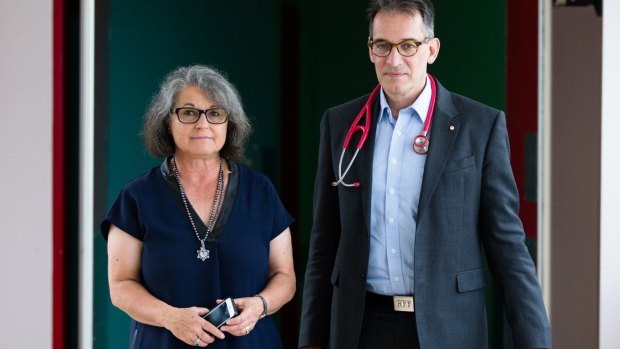
Co-ordinator of the paired kidney exchange program Claudia Woodroffe and nephrologist Paolo Ferrari.Credit: Edwina Pickles
SURGEON KOROUSH HAGHIGHI met Leon Sidd twice before removing his kidney. He needed to be sure that Sidd really wanted to give away the organ, and understood the risks involved. Risks such as...? "Dying," Haghighi says. "It is major surgery. There's a risk of bleeding. Infection."
Kidneys lie at the back of the abdominal cavity and filter waste products from the blood. The operation to extract one – called a nephrectomy – is usually done laparoscopically: the surgeon makes three or four small cuts in the patient's belly and side, then detaches the organ from blood vessels and the ureter with the help of a camera and tiny probes. "You still have to cut a hand-sized hole to remove the kidney," says Henry Pleass, a surgeon at Sydney's Westmead Hospital, whose patient in the exchange was Neville Livingston, a 48-year-old crane operator.
Livingston had eagerly signed up to the program in order to help his wife, Gail, get a kidney. As always, though, Pleass felt a bit weird about taking a healthy organ from a fit and well individual – "someone whose life was not at risk until you put them to sleep and cut a hole in them". After all, the foundation stone of medical ethics is primum non nocere: first, do no harm. "It goes against our fundamental principles," says Pleass, who nevertheless has heartfelt admiration for individuals such as Sidd and Livingston: "They are selfless, brave people." Haghighi agrees: "These patients are exceptionally precious."
By mid-morning, all seven kidneys had been separated from their owners and packed into ice-filled polystyrene containers, much like beer eskies. Four of the organs were to be flown from Melbourne to Sydney, or vice versa. The others had only to make road journeys.
In India, where clogged highways would otherwise cause unacceptable delays, ambulances carrying organs whiz along "green corridors": police move drivers to the sides of streets and keep the lights green. The Indians are even experimenting with organ delivery by drones. In Australia, we rely on courier companies. If a van gets stuck in traffic, Claudia Woodroffe can do little but drum her fingers anxiously on her desk.
At least there are frequent flights between Sydney and Melbourne. "It gets tricky if we're going from the west coast to the east coast," Woodroffe says. "If we miss one flight, the next one may not be 'til four or five hours later." I tell her I had imagined Learjets idling on runways, waiting to whisk kidneys to their destinations. "Chartered flights are not an option," she says. "They're awfully expensive."
When the kidneys go Qantas and Virgin, they don't even travel in the cabin. Instead, they are loaded into pressurised compartments in cargo-holds. But according to Woodroffe, the airlines treat them as the equivalent of VIP passengers. "The pilots know when they have a human organ on board."
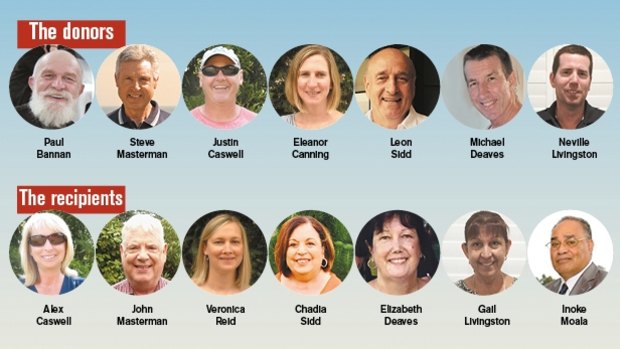
BECAUSE AUSTRALIA HAS A HIGH RATE of kidney disease and a relatively low rate of organ donation (we rank 20th in the world), the wait for kidney transplants can be long. Inoke Moala, a Tongan-born pastor of the Wesleyan Methodist Church in Melbourne, was one of more than 1100 people on the list when he got a phone call late last year from John Kanellis, head of the transplantation unit at the city's Monash Medical Centre. Kanellis had exciting news: an unprecedentedly large and complex kidney exchange was being planned and seemed likely to result in a surplus kidney (thanks to Paul Bannan, there were more donors than recipients). Though 60-year-old Moala was not registered with the program, he had been selected to receive the organ.
"The lucky kidney at the end," Kanellis called it, though, in fact, it was the first of the seven to be delivered, arriving at Monash at 11.10am on the day of the exchange. Moala "was well matched. That's why he got it", Kanellis tells me. "But that kidney could probably have gone to any one of 500 people in Australia." Says Moala: "I don't feel lucky. I feel blessed."
The next kidney to be delivered – at 12.05pm – was for Alex Caswell. Since the birth of her three-year-old son, Caswell had suffered from the debilitating, cement-in-the-veins exhaustion common to people with end-stage kidney disease. "I'd be lying on the couch, not feeling well," she says, "and Max would come over and say, 'It's okay, Mummy, you'll be okay.' He'd stroke my head. Or if I fell asleep when I was playing with him on the floor, I'd wake up and he'd be sitting there holding my hand. It wasn't what I wanted Max to remember."
A former clerk of the magistrates court in Hobart, 44-year-old Caswell had already survived breast cancer. Given the all-clear in September 2014, she immediately registered for the paired kidney exchange program with her husband Justin. Now both were in Royal Melbourne Hospital, Justin recovering from his morning nephrectomy and Caswell being wheeled away to get a transplant.
At 3pm, the kidney with Gail Livingston's name on it arrived at Westmead Hospital in Sydney. Livingston, 53, a childcare worker, had suffered from polycystic kidney disease since she was 18. She says it was her husband, Neville, who insisted they sign up for the exchange program: "He didn't hesitate for a second. Which is a huge, huge thing." When the date for the operations was set, he dismissed their children's anxieties. " 'We'll be fine. We're going in, getting a kidney and we'll be home.' That was his attitude," Livingston says. "People say to me, 'You've got strength.' I say, 'You should meet my husband.' "
Three more kidneys were delivered over the next few hours: one to Elizabeth Deaves at Newcastle's John Hunter Hospital, one to Chadia Sidd at the Prince of Wales Hospital in Sydney, and one to John Masterman at the Royal Melbourne. Masterman says he felt grateful to his brother, Steven, whom he hoped would cope as well with one kidney as had their mother, Masterman's first transplant donor. "Mum is 81 and it hasn't affected her at all," Masterman says. "She played tennis until she was about 79. The only reason she stopped was because she hurt her foot coming down the Great Wall of China."
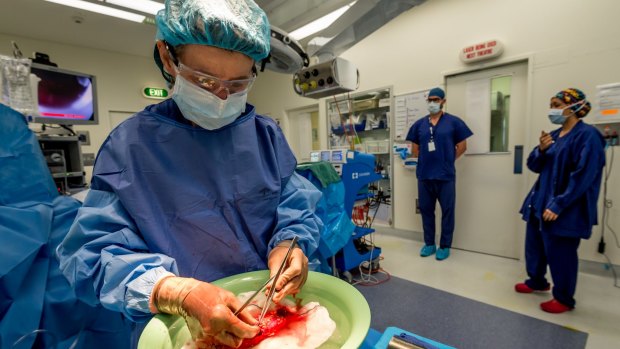
Surgeon Amanda Robertson works on the donor kidney at Melbourne Private Hospital.Credit: The Age
CLAUDIA WOODROFFE HAD SPENT THE DAY firing off text messages, swigging Diet Coke ("maybe it's the caffeine that helps") and tracking the movements of couriers. By late afternoon, she was staring with mounting concern at the Qantas website. The seventh kidney, earmarked for social worker Veronica Reid, was supposed to have left Sydney for Melbourne at 2pm, but the flight's departure had been repeatedly delayed. Now Woodroffe was being told the plane had taken off but been forced to turn back. (A Qantas spokesmen has since said it had problems with steering and didn't ever get off the ground.) Passengers and cargo were being unloaded and put on other aircraft.
Woodroffe remembers saying: "Please check that my kidney is there! Please, please, please check that my kidney is there!" In Melbourne, Austin Hospital's donor co-ordinator, Megan Sandiford, was closely liaising with Woodroffe and Reid. "Megan was wonderful," Reid says. "She was coming in every half-hour to say, 'It hasn't left' or 'It's left but it's turned around'. I tried to relax and be as calm as I could about it." The organ finally arrived at 7.25pm.
Recalls Sandiford: "I was very happy to wheel that kidney into the operating theatre and say, 'I've got it!' " We think of organ transportation as a frantic race against time, but Paolo Ferrari says evidence from the paired exchange program suggests the need for speed may be slightly exaggerated. "We've done an analysis of the first 100 kidneys that were shipped around the country," he says. The results were surprising: "You might have a kidney that's a little bit sleepy – that doesn't start working from the get-go – and intuitively you would expect it's the kidney that has been the longest on ice. You would think the longer the kidney had been out of the body, the longer it would take to kick-start. But that is actually not the case. We've had four kidneys that had more than 12 hours on ice, and they all worked well from the beginning."
Still, Woodroffe knows any hold-ups or uncertainties take a toll on donors and recipients. "They place their trust in us, so we don't want to let them down," she says. "I remember once I got an SMS saying, 'The kidney has landed', when I was with the young recipient. When I told her, she burst into tears of relief." Thinking about that, Woodroffe's own eyes swim. "I still get quite emotional about it as well," she says.
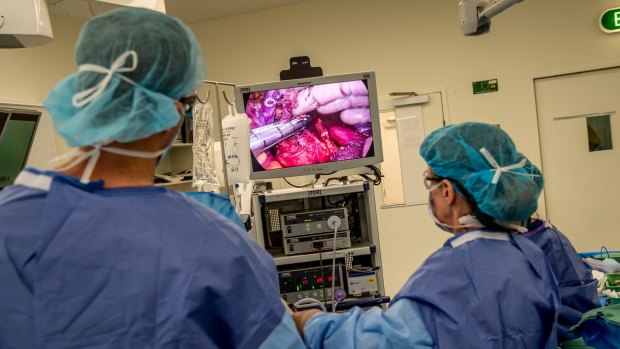
Surgeon Amanda Robertson performing transplant surgery at Melbourne Private Hospital.Credit: The Age
THERE ARE NO GUARANTEES. After a six-way kidney exchange in May 2014, one of the recipients, a young Victorian woman, died. But Steve Holt says kidney transplants are generally highly successful: the five-year survival rate is up around 90 per cent, and most transplanted kidneys last 10 years or more. "Sometimes it's 25 or 30 years," Holt says.
The beauty of the paired kidney exchange program is that it makes transplants available to people who might otherwise die waiting for them. "If they stay on the deceased-donor waiting list, some of them have a chance of a match as low as one in 100," Paolo Ferrari says. "One of the patients who received a transplant from our program had been on dialysis for nearly 17 years, and on the deceased-donor waiting list for the same time. Within a few months, we found him a match. He had a transplant and he's doing very well now."
Ferrari points out that dialysis is a major drain on the health budget. It costs taxpayers about $65,000 a year for each patient, he says, compared with only $15,000 a year to maintain the health of a kidney-transplant recipient after the initial outlay for surgery (which is provided free of charge in public hospitals). There are other economic advantages: whereas a person on dialysis can work at most two or three days a week – and many are too ill to work at all – a transplant recipient may well return to full-time employment. But most importantly, says Ferrari, the person with the new kidney is likely to have a longer, more enjoyable life than a dialysis patient.
What of the donor? Does giving away a kidney shorten a person's life expectancy? "The short answer is 'no', " Ferrari says. "Are there any live donors who have ended up developing kidney disease and kidney failure? Yes. Would the outcome have been different for these patients if they had two kidneys? No one can tell, but my gut feeling is that it probably would not have been in any way different. Because if someone is struck by kidney disease, you end up with kidney failure whether you have one kidney or two kidneys. Usually, kidney disease affects both kidneys."
Ferrari contends that the paired kidney exchange program delivers hidden psychological benefits. "Almost invariably the donor has the perception that they have helped two people, even though they have given only one kidney away," he says. "They feel they've helped their loved one and they've helped someone else." For doctors, too, the mutual trust and collaboration involved in the exchanges can be uplifting. "The donors are the true champions," says surgeon Koroush Haghighi. "We're just there to help them. But for us to be part of the process is nice." Royal Melbourne surgeon Amanda Robertson agrees: "It's a fabulous experience."
For Robertson, who operated on both Alex and Justin Caswell, what's puzzling is how slow some doctors have been to embrace the program. "It's opened up transplantation in a big way," she says. "You look at the overseas experience and now the Australian experience and the results are great. I don't quite understand the resistance."
It seems to Ferrari that initial scepticism has worn down considerably, though many remain suspicious of so-called "altruistic donors" – people like Paul Bannan who give away organs without expecting anything in return. Seven have come forward in the five-year life of the program. "Medical professionals are quite conservative and think, 'These people must be nuts,' " says Ferrari, who argues that anyone who wasn't sane or genuinely well-intentioned would be quickly screened out. "There's a lot of testing. It's a very long process."
At Westmead, surgeon Henry Pleass says he wouldn't dream of giving a kidney to a stranger. "Absolutely not." For a start, he feels a responsibility to provide for his family: if he died during surgery, his kids could lose their home. "The other thing: what if one of my children had kidney failure in five years' time? I couldn't help them." But Pleass well understands the difference between kookiness and kindness. "Some people are just remarkably generous. It never ceases to amaze me."
Bannan, who works as a maintenance fitter in a confectionery factory, is also a volunteer fire-fighter. On Victoria's Black Saturday – February 7, 2009 – he drove a team of fellow volunteers through the fire-front to reach the isolated community of Flowerdale. For the same reason that he doesn't much like talking about that, he worries that his role in the organ exchange has been overblown. "At the end of the day I only gave one person a kidney," he says. "Everybody else stood up and handed over a kidney as well."
In fact it was Bannan's kidney, the extra one, that made such a large exchange possible, Ferrari says. Without it, "four of the seven pairs would have been excluded. Four people would still be waiting for a kidney."
Alex Caswell now has the energy to play with her son. "I feel like I did when I was 21," she says. "We've been out fishing in the boat, even running around outside playing with the ball. Max has loved it."
The recipients and donors still don't know who got whose organs but Claudia Woodroffe has passed anonymous messages between them. "I wrote to the person who got my kidney," says Eleanor Canning, "and I got a card saying, 'Thank you. It's turned my life around.' " Fourteen lives came together last November 19, and each was to some extent changed by the experience. Steve Holt smiles. "I have days when I don't really like human nature," the nephrologist says. But a day like November 19? "That makes me really very happy. It makes me optimistic about the human race."